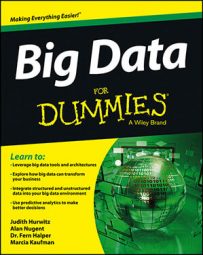Your big data architecture also needs to perform in concert with your organization’s supporting infrastructure. For example, you might be interested in running models to determine whether it is safe to drill for oil in an offshore area given real-time data of temperature, salinity, sediment resuspension, and a host of other biological, chemical, and physical properties of the water column.
It might take days to run this model using a traditional server configuration. However, using a distributed computing model, what took days might now take minutes.
Performance might also determine the kind of database you would use. For example, in some situations, you may want to understand how two very distinct data elements are related. What is the relationship between buzz on a social network and the growth in sales? This is not the typical query you could ask of a structured, relational database.
A graphing database might be a better choice, as it is specifically designed to separate the “nodes” or entities from its “properties” or the information that defines that entity, and the “edge” or relationship between nodes and properties. Using the right database will also improve performance. Typically the graph database will be used in scientific and technical applications.
Other important operational database approaches include columnar databases that store information efficiently in columns rather than rows. This approach leads to faster performance because input/output is extremely fast. When geographic data storage is part of the equation, a spatial database is optimized to store and query data based on how objects are related in space.
Organize big data services and tools
Not all the data that organizations use is operational. A growing amount of data comes from a variety of sources that aren’t quite as organized or straightforward, including data that comes from machines or sensors, and massive public and private data sources. In the past, most companies weren’t able to either capture or store this vast amount of data. It was simply too expensive or too overwhelming.
Even if companies were able to capture the data, they did not have the tools to do anything about it. Very few tools could make sense of these vast amounts of data. The tools that did exist were complex to use and did not produce results in a reasonable time frame.
In the end, those who really wanted to go to the enormous effort of analyzing this data were forced to work with snapshots of data. This has the undesirable effect of missing important events because they were not in a particular snapshot.
MapReduce, Hadoop, and Big Table for big data
With the evolution of computing technology, it is now possible to manage immense volumes of data. Prices of systems have dropped, and as a result, new techniques for distributed computing are mainstream. The real breakthrough happened as companies like Yahoo!, Google, and Facebook came to the realization that they needed help in monetizing the massive amounts of data they were creating.
These emerging companies needed to find new technologies that would allow them to store, access, and analyze huge amounts of data in near real time so that they could monetize the benefits of owning this much data about participants in their networks.
Their resulting solutions are transforming the data management market. In particular, the innovations MapReduce, Hadoop, and Big Table proved to be the sparks that led to a new generation of data management. These technologies address one of the most fundamental problems — the capability to process massive amounts of data efficiently, cost-effectively, and in a timely fashion.
MapReduce
MapReduce was designed by Google as a way of efficiently executing a set of functions against a large amount of data in batch mode. The “map” component distributes the programming problem or tasks across a large number of systems and handles the placement of the tasks. It also balances the load and manages failure recovery. Another function called “reduce” aggregates all the elements back together to provide a result.
Big Table
Big Table was developed by Google to be a distributed storage system intended to manage highly scalable structured data. Data is organized into tables with rows and columns. Unlike a traditional relational database model, Big Table is a sparse, distributed, persistent multidimensional sorted map. It is intended to store huge volumes of data across commodity servers.
Hadoop
Hadoop is an Apache-managed software framework derived from MapReduce and Big Table. Hadoop allows applications based on MapReduce to run on large clusters of commodity hardware. The project is the foundation for the computing architecture supporting Yahoo!’s business. Hadoop is designed to parallelize data processing across computing nodes to speed computations and hide latency.
Two major components of Hadoop exist: a massively scalable distributed file system that can support petabytes of data and a massively scalable MapReduce engine that computes results in batch.

